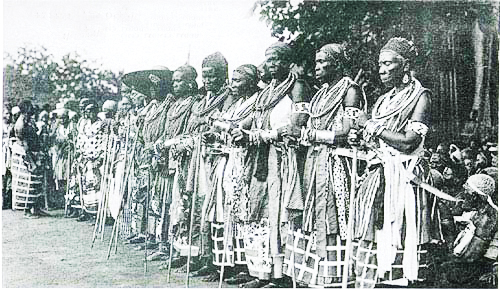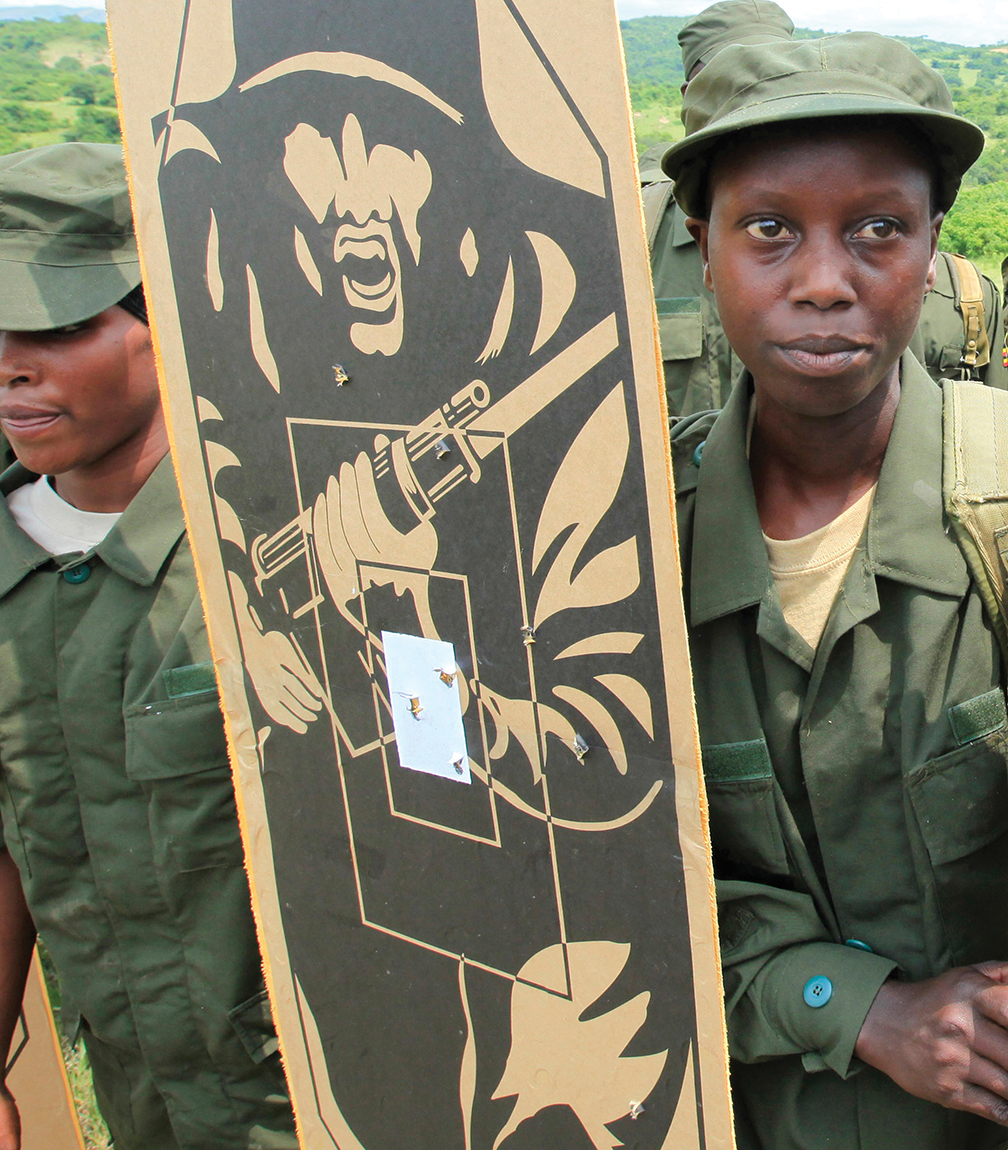Soldiers Not Numbers
Integrating Women Into African Militaries Must Go Beyond Quotas and Traditional Roles
ADF STAFF photos by REUTERS
At one time, some of the fiercest and most capable Soldiers in Africa were women: the Amazon warriors of the Dahomey Kingdom. The all-female fighting force, recruited from captives and the indigenous population, also served as royal bodyguards to the king.
The force was formed in the 17th century, growing out of a contingent created to hunt elephants. By the mid-19th century, the number of fighters had grown to between 1,000 and 6,000 women, comprising about a third of the Dahomey Army. The kingdom, which was in what is now southern Benin, was fairly progressive for its time; women had rights not afforded in many other societies.

The Amazon women fought valiantly up to and through the Franco-Dahomean Wars in 1890 and 1892. By the time of French conquest in 1892, most of the Amazons had been wiped out. The Dahomey warriors are remembered with pride in modern-day Benin. In 2010, Benin was one of 13 former French colonies to send a military contingent to Paris for a parade marking Bastille Day. It chose to send its elite female Soldier corps known as Le Benin Amazone.
MORE THAN JUST NUMBERS
In the 21st century, women continue to serve with distinction in African security forces. Experts agree that having women in African military, police and security forces is a positive thing, because it provides representation to more than half of a nation’s population. To that end, several nations, particularly in Southern Africa, have advanced the integration of women into security forces.
According to the Southern African Development Community Gender Protocol 2014 Barometer, women make up 28 percent of South Africa’s defense forces, 38 percent of the Seychelles’ police force and 52 percent of the Seychelles’ correctional services. Zimbabwe has the highest proportion of women serving in peacekeeping forces at 35 percent. In 2013, Namibia led that category with 46 percent. The target for each of these categories in 2015 is 50 percent.
Somalia, a nation coming out of more than 20 years of lawlessness and terrorist attacks, has begun to bring women into its fledgling national Army. As of mid-2014, about 1,500 of the nation’s 20,000 Soldiers were women. Twenty-five-year-old Naeemo Abdi is one of them. “It was difficult, but I must do this to serve my country unreservedly,” she told The Associated Press. “Gender is not boundary. If committed, women can work far better than men.”
Even so, her choice to leave domestic life in 2012 to join the Army was met with skepticism and, at times, hostility. Her husband and family opposed the decision. Once, as she frisked a man about to enter a Somali police station, he snapped: “Woman and Soldier?”
Others complain of discrimination, saying they are trapped in menial jobs. Many provide security at police stations. “The only problem is women get relegated and don’t get promoted to higher roles,” Soldier Shukri Hassan told the AP.
“Getting senior female officers would inspire more women to join the Army,” said Soldier Halimo Maalin.
TRANSFORMING LEADERSHIP STRUCTURES
Female leadership is among the top challenges for integration of women into military and police forces. A major theme at a regional gender conference in Windhoek, Namibia, in June 2014 was that mere numbers are not enough. Instead, nations should focus on involving women in gender issues at the decision-making level.
African nations are showing an interest in the topic. Representatives from Botswana, Malawi, Mozambique, Namibia, Senegal, Sierra Leone and Zambia attended the conference and shared strategies and best practices.

Some women already are serving in high levels of military command structures around the continent. Again, Southern Africa is notable. Maj. Gen. Nontsikelelo Memela-Motumi of the South African National Defence Force is deputy chief of human resources and the force’s highest-ranking woman. She wrote about the need for women in decision-making positions in the September 2013 issue of South African Soldier magazine.
“We need more women at [the] leadership level to serve not only as role models, but to propel the transformation agenda towards non-sexism,” she wrote. “Significantly, there is a pervasive gender gap in women’s substantive and symbolic representation in the military command structures.”
Cheryl Hendricks, professor of political science at the University of Johannesburg, agrees. But it will take time for women to rise to the levels necessary to have substantive influence. Women who enter security forces must be given reasons to stay in the form of training and opportunities for advancement, she said. With that advancement comes the possibility of having women in decision-making roles that can bring reform to the security sector.
“We’ve concentrated so much on just getting women in there, and so what you see is women go in, but they don’t stay there for very long either,” Hendricks told ADF. “So after three, four years, they move out to somewhere else. So retention, not just recruitment — retention is a big issue in the security sector.”
Security forces must strike a balance between proper training and a commitment to advancing women. “You don’t want to put people in positions that they’re not capable of delivering on,” Hendricks said. “That just shoots you in the foot. So you need to give people the requisite training to do so. But you can fast-track training as well. So instead of it taking you 20 years, it could take you 10 years if you have a concerted effort to do this. So you have to look out for capable women, identify them and make sure that you fast-track them.”
AVOIDING THE GENDER TRAP
Hendricks says she always starts with the assumption that women are equal citizens in society and deserve an opportunity to pursue whatever service or employment interests them, as long as they are qualified for it. A more representative security sector will consider the needs of everyone in a society. Similar arguments have been made and acted upon across the continent with regard to integrating racial and ethnic groups into security forces. So the same kinds of arguments should hold true for women. Integrating women, like ethnic groups, achieves the basics of security sector reform, Hendricks said — “a more representative, legitimate, accountable and responsive security sector.”

Where militaries must be careful, she said, is in presuming that women bring unique gender-based qualities to military and police service. For example, some assume that women are better communicators, more empathetic and more likely to seek peace. Sometimes it is assumed that they will be better at interacting with civilian women and children or be more likely to advocate against gender-based violence. Sometimes these assumptions are true, but there also are men who excel at such things. “So we can’t just make a homogenous argument like that,” Hendricks said. “What we need to do is to find out what are the skill sets that are necessary for a particular society’s security sector or a particular peace mission, etc., and then look at how we can train everybody to fulfill those skill sets.”
Hendricks calls this the “gender trap.” If officials presume that women are valuable only because they bring a particular set of skills, then only women will be left with the burden of transforming gender relations in the security sector. “That’s why I tend to emphasize the rights-based argument,” she said. “For any other sector, we don’t have to go and look for the unique qualities of women to be in the business sector or in government, etc. It’s taken as they belong there, too. But somehow when it comes to the security sector, we need to be finding these rationales for women to be in this particular sector.”
Boubacar N’Diaye, chairman of the Africa Security Sector Network, said the issue is one of balance. Women should be included, welcome and in positions of authority. N’Diaye said he has had to address the question of why it’s important for women to be in the security sector many times from African officials as he works on reform programs across the continent.
“I say, well, don’t forget that not long ago during colonialism, Europeans thought that African men were not capable of being part of the military and could not be in combat positions, could not be in command positions,” he said. “So how would you feel if that were to continue to exist right now as we speak? And I think that drives the point home that it is indefensible to continue to have security apparatuses that exclude more than half of the population, again, literally deprive itself of so much talent and so much energy.”


Comments are closed.